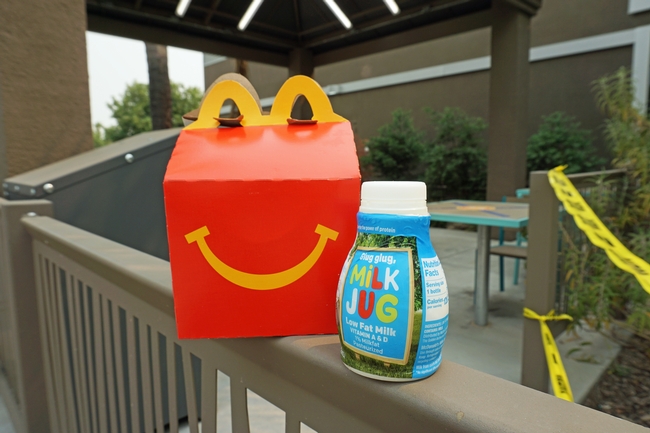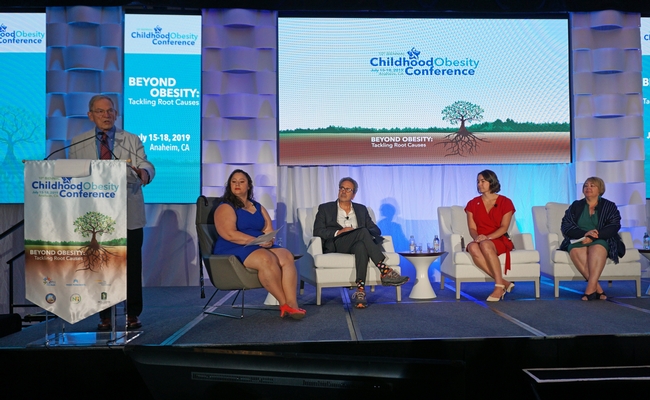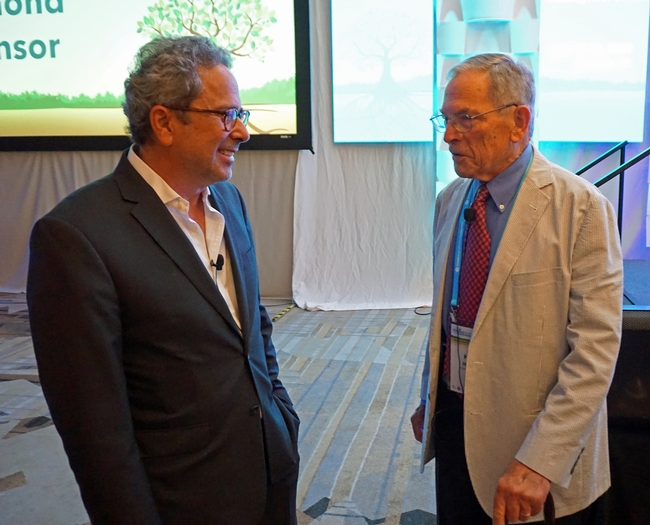Posts Tagged: sugar
New policies can inspire families to provide healthy beverages to children
At fast food and sit-down restaurants across California, kids' meals come with water or milk automatically. At least, that should be the case since state law requires restaurants to offer the healthy beverages by default to reduce the amount of sugary beverages served to children.
California Senate Bill 1192, authored by Sen. Bill Monning (D-San Luis Obispo), went into effect Jan. 6, 2019, but research by the UC Nutrition Policy Institute (NPI) has found that implementation has not been universal and more can be done. The results, along with results from a similar study in Wilmington, Del., were published Aug. 20 on HealthyEatingResearch.org.
Before the law, 10% of menu boards observed by the researchers in California listed only the healthy beverages. Data collected after the law went into effect showed 66% of menu boards list the healthy default beverages. The researchers also collected data on the proportion of cashiers who verbally offered only healthy beverages with kids' meals when orders were placed. This happened only 5% of the time before the law was enacted, and dropped to 1% after.
“Parents look at menu boards and kids look at menu boards, but it is likely that what the cashier says also influences which drink they choose,” said Lorrene Ritchie, NPI director and UC Cooperative Extension nutrition specialist. Ritchie was the lead researcher on the California portion of the study. “In our data collection, we would order a kids' meal and wait for them to offer a drink. But mostly they said, ‘What drink do you want?' instead of ‘Do you want water or milk with that?'”
The law doesn't specify whether the cashier must offer the default beverages, but the spirit of the law suggests they should, as it would likely have a greater impact on the selections that children and parents make, Ritchie said.
According to Gail Woodward-Lopez, an NPI researcher and co-investigator on the study, most restaurant managers expressed support for the legislation, but didn't know much about it.
“NPI in partnership with the California Department of Public Health is working with some local health departments to provide training and materials to help restaurants comply with the letter and spirit of the law,” Woodward-Lopez said. “Our next step is to measure whether this health department support is effective.”
The dire need to direct children away from sugary sodas is clear. Empty calories from soda and other sugar-sweetened beverages is the No. 1 cause of obesity in children, Ritchie said. Obese children are at least twice as likely as non-obese children to become obese adults. Obese children and adults are at greater risk for Type 2 diabetes, heart disease, stroke, high blood pressure, high cholesterol, certain cancers, asthma, low self-esteem, depression and other diseases. The Centers for Disease Control and Prevention names obesity as one of the conditions that increase risk of severe illness from COVID-19.
Many open questions remain, such as how drinks are portrayed on drive-thru signs and offered by drive-thru order takers. The COVID-19 pandemic has also altered the way Americans purchase food, with increased online ordering, delivery and drive-thru usage. In-store kiosk ordering is also growing in popularity.
“The role of default beverage policies in this context is important and not well understood,” Woodward-Lopez said.
Woodward-Lopez and Ritchie are working with colleagues around California and across the country to design follow-up studies of newer food technologies and beverage policies being passed elsewhere, to determine how government policies can protect children's health by steering them toward healthy beverage consumption.
The newly published research was funded by the Robert Wood Johnson Foundation and by the California Department of Public Health with funding from the United States Department of Agriculture.
Soda tax advocates ride a political roller-coaster
When Genoveva Islas was 12 years old, she was responsible for giving insulin injections to her diabetic tia, her aunt.
“Tia lost her toes, lost her leg, lost her life,” Islas said. “This is a very important fight.”
Islas is director of Cultiva La Salud in Fresno, which works to address poor nutrition and physical inactivity in the San Joaquin Valley. The fight Islas referred to is the “soda wars,” a battle to reduce the amount of sugar-sweetened beverages (SSBs) consumed by Americans. SSBs are the single most significant source of sugar in Americans' diets, amounting to nearly half of sugar intake. They have been unequivocally linked to increases in obesity, diabetes, heart disease, liver disease, tooth decay and some cancers.
Islas talked about the tragic fate of her tia at the July 2019 California Obesity Conference in Anaheim, where 1,025 public health, nutrition, science and political leaders convened to share strategies for overcoming the childhood obesity crisis in the United States. She was part of a panel on taxing sugary drinks to reduce SSB consumption and fund community health programs.
“I'm here because I believe health is a right, not a luxury,” Islas said. “A soda tax is a fight for the community I love.”
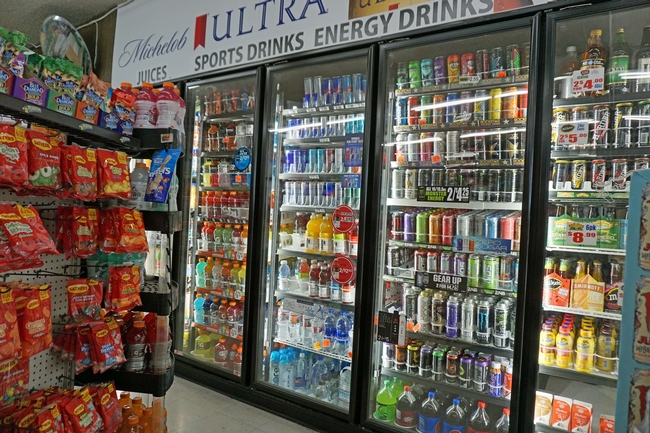
“I say regressive is the incidence of diabetes in my community, the incidence of heart disease in my community,” Islas said. “The California Central Valley has the highest rates of drinking water violations. Bottled water is costly. People are choosing sugar-sweetened beverages when it is the most affordable choice for them.”
Money raised by the soda tax, Islas continued, could support water quality improvements and encourage the public to drink free and safe tap water.
California Assemblymember Richard Bloom (D-Santa Monica), who has proposed soda tax legislation several times, was also on the soda tax panel.
“The soda industry has poured a huge amount of money toward lobbying in Sacramento against soda restriction laws,” he said.
Bloom suggested that soda tax proponents be clear about the implications of childhood obesity and associated diseases when working to implement soda tax laws.
“Words like ‘epidemic' and ‘crisis' are used so much, they start to lose their meaning,” Bloom said. “We have a lot of statistics on the science of sugary drinks, but we don't talk about the misery this visits upon people and families and communities – amputations, heart disease, cancer. We need to start telling those stories viscerally.”
Kenneth Hecht, director of policy at UC's Nutrition Policy Institute, moderated the panel discussion. He said that a soda tax is the most cost-effective intervention to reduce soda consumption. It has been implemented and studied in Berkeley, Calif., where voters in 2014 passed a local initiative to tax soda and other sugar-sweetened beverages 2 cents per ounce. Three years later, residents reported drinking 52 percent fewer servings of sugary drinks than they did before the tax was imposed.
“Soda taxes work,” said Kristine Madsen, director of the Berkeley Food Institute and professor at UC Berkeley School of Public Health, who evaluated the Berkeley soda tax and also spoke at the conference.
The bulk of Berkeley's soda tax revenue is dedicated to supporting nutrition education and gardening programs in schools and allocated to local organizations working to encourage healthier behaviors in Berkeley.
San Francisco, Oakland and Albany also passed soda taxes. Other communities were planning to put soda tax initiatives on the ballot, but were stymied by a preemptive strike waged by the soda industry. In June 2018, the California Legislature passed a bill to preempt any new local beverage or food taxes until 2031. According to Assemblymember Bloom, beverage companies spent millions to get an initiative on the ballot that would have prevented local communities from raising taxes without a two-thirds vote, up from 55% of the vote currently needed. They offered to drop the initiative if the California Legislature would impose a moratorium on local soda taxes.
Bloom called the preemption a “disgusting tactic.”
“We had to capitulate to that to protect our local governments,” Bloom said. “It was never a sprint to address soda tax, but now it's become a marathon.”
Public health activists were also outraged.
“If you have enough money, you can put anything on the ballot and use that to extort lawmakers to get what you want,” said Mark Pertschuk, director of Grassroots Change and a conference speaker. “This is a war on local democracy. We need to educate people on what preemption is.”
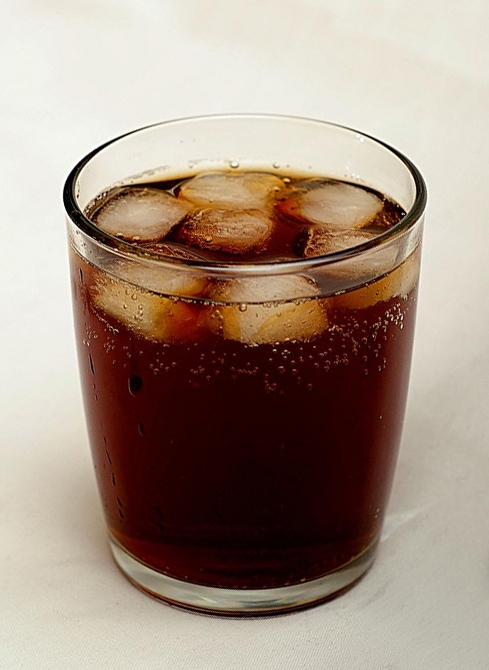
“It's the same as being tobacco free and drug free,” he said.
One public organization leading the way is UC San Francisco (UCSF), which employs 22,000 staff, academics and medical professionals. In 2015, all its campuses and buildings removed sugar-sweetened beverages from food service outlets and vending machines as part of its Healthy Beverage Initiative. Laura Schmidt, professor in the Institute for Health Policy Studies at UCSF, discussed the ban at the Childhood Obesity Conference.
“When you live in a saturated environment, where it's always in reach, that makes it difficult to say no,” Schmidt said. “We have to change the environment. All effective solutions follow the iron law of public health. If you reduce availability of harmful substances in the environment, you will reduce consumption.”
At the culmination of his Childhood Obesity Conference talk, Bloom announced the recent formation of Californians for Less Soda, a new coalition of public health and health equity advocates and health professionals aligned to decrease consumption of sugar-sweetened beverages in California through effective policies.
Joining forces to promote child health and wellness
According to current statistics, approximately 40 percent of school-age children in the U.S. are overweight or obese. This statistic is reflected in rising rates of diabetes, pre-diabetes, and heart disease risk factors. Nearly one-quarter of all children are pre-diabetic or diabetic at the time when they leave high school, a figure that has increased dramatically in the last decade. Dental problems, the other very common health problem of youth, carry the potential for current and future pain, infection, and tooth loss. Although low-income children and children of color are at particular risk for both conditions, risk is unacceptably high for all children.
It is important to note that these all-too-common conditions share the same critical risk factor: consumption of sugary foods and beverages. Unknown to many, over half of the added sugar consumed by children is ingested in liquid form—soda, fruit drinks, sports drinks, energy drinks, and other pre-sweetened beverages including iced teas and others. For teenagers sugar-sweetened beverages are the single largest source of calories in their daily diet. Further, research has demonstrated that liquid sugar is more highly related to obesity than added sugar coming in solid form.
To improve the medical and dental health of our children we need to help children and families find ways to reduce their consumption of sugar-sweetened beverages.
Fortunately research is being conducted to find effective ways to reduce children's sweetened beverage consumption.
- Reduce provision of sweetened beverages in the school, after school and childcare settings. UC ANR's Nutrition Policy Institute (NPI) has documented dramatic reductions in sugary beverage consumption after the enactment of state restrictions on the sale of highly sugared beverages in California schools and childcare. While much has been accomplished, more can be done to see that these kinds of restrictions are fully maintained.
- Offering children easy access to water stations and other free tap water sources in childcare settings, schools and recreational facilities provides a healthful alternative to sugary beverages.
- Encourage strong nutrition education programs for children. UC Cooperative Extension's EFNEP and statewide SNAP-Ed programs have been leading efforts to educate children on the value of a healthy diet including the risk of consuming too many sugary beverages.
- Similarly, educating families on healthy eating and on the benefits of reducing sugar-sweetened beverage consumption can support and reinforce the messages to children in the school-based programs.
A consistent message on sugary beverages delivered to families by dental and medical health practitioners, in tandem with other educational and community efforts, can substantially benefit children's health. As respected community members, dental and medical health practitioners are in a position to deliver consistent messages to families and also to work with community agencies and groups, including UC ANR and its affiliates, to initiate and support efforts to reduce children's and families' sugary beverage consumption. Our children deserve a healthy start.
For more information, see:
- Nutrition Policy Institute (http://npi.ucanr.edu)
- National Drinking Water Alliance (http://www.drinkingwateralliance.org/about)
- Dooley D, Moultrie N, Sites E, Crawford P. Primary care interventions to reduce childhood obesity and sugar-sweetened beverage consumption: Food for thought for oral health professionals. Journal of Public Health Dentistry, 16 June 2017. DOI:10.1111/jphd.12229.
The health impacts of sugary drinks
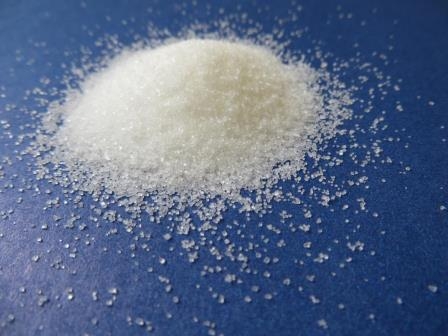
Excess sugar consumption contributes to obesity, tooth decay, early menses in girls, and chronic diseases including diabetes and heart disease. To add to the damage, doctors are now attributing too much dietary sugar to non-alcoholic fatty liver disease, which can lead to cirrhosis of the liver.
It's enough to make you sit up and listen to the warnings about too much soda, sugary drinks, and sugar-laden processed foods.
What is a sugary drink? It's any beverage, more or less, with added sugar or other sweeteners, including high-fructose corn syrup. The long list of beverages includes soda, lemonade, fruit punch, powdered fruit drinks, sports drinks, energy drinks, sweetened coffee and tea drinks, and many flavored milk products.
People are becoming aware of the concerns of too many sugary drinks, and steps are being taken to reduce their consumption. Some K-12 school districts across the nation are limiting sales of soda, and the City of Davis will soon require that restaurants offer milk or water as a first beverage choice with kids' meals.
UC Cooperative Extension, the county-based outreach arm of UC Agriculture and Natural Resources, is partnering with health agencies and conducting public service programs for youth and families about sugary drinks. UC ANR Cooperative Extension in San Joaquin County recently presented a "Rethink Your Drink" parent workshop in conjunction with the county's Office of Education, and Solano County Cooperative Extension is working with the California Department of public health to engage youth in "Rethink Your Drink" programs.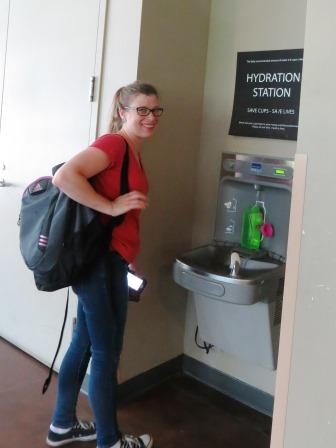
Lucia Kaiser, UC ANR Cooperative Extension nutrition specialist, co-authored a policy brief about California's rural immigrants who have poor-quality tap water, or perceive tap water to be bad. Kaiser, who is also a nutrition faculty member at UC Davis, noted that studies have found a link between water quality and consumption of sugary drinks, which is a concern in low-income communities that don't have resources for clean water.
As of this month (July 2015), UC San Francisco is no longer selling sugary beverages on its campus, and UCSF has launched a Healthy Beverage Initiative. UC Berkeley held a Sugar Challenge this year, and UC Davis is conducting a Sugar Beverage Study on women.
Scientists at UC San Francisco, UC Davis, UC ANR's Nutrition Policy Institute, and other universities are studying the health effects of sugar and implementing health outreach programs. And UC's Global Food Initiative is building on the momentum of excessive sugary-drink consumption.
A healthy alternative to sugary drinks? Water, of course. Many universities and public places are replacing traditional drinking fountains with water stations so that students and others can fill their own bottles and have water “on the go.” And UC President Janet Napolitano is working with the Nutrition Policy Institute on a bold and sensible request to place water on the USDA's MyPlate nutrition guidelines.
The next time you're thirsty, drink wisely to your good health.
Additional information:
- Sugary drinks are hiding under a 'health halo'; UC ANR Food Blog, Aug. 6, 2014
- Nutrition Policy Institute, UC ANR
- UCSF Launches Sugar Science Initiative, a national initiative
- Learn the Facts about Sugar: How Sugar Impacts your Health, UCTV Video, May 2015
- The Hidden Costs of Sugar; UCSF news release, Nov. 2014
- Why Sugar? Why Now?, blog article by Laura Schmidt, UCSF
Not so sweet: Sugar's dark side
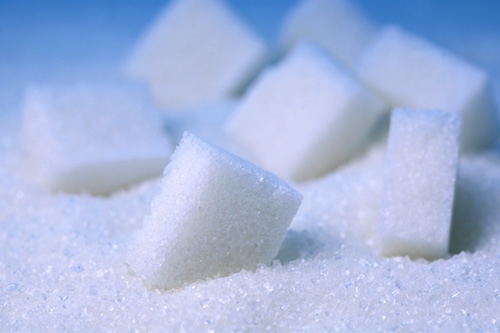
America is paying the price for its growing sweet tooth.
Just look at the rising rates of diabetes and obesity, said speakers at a March 17 symposium, “Sugar Highs and Lows: Dietary Sugars, the Brain, and Metabolic Outcomes,” at UC Davis.
The symposium focused on sugar consumption and its impact on health. The event was sponsored by the Center for Obesity Assessment, Study and Treatment (COAST) at UC San Francisco, the UC Office of the President, UC Berkeley and UC Davis.
UCSF pediatric endocrinologist and COAST researcher Robert Lustig and UC Davis molecular biologist Kimber Stanhope discussed the downsides of a type of sugar called fructose.
“The government pays twice for obesity: first for the corn subsidy (to make high-fructose corn syrup), and then for emergency room heart attacks and health care,” Lustig said.
It’s not just sugar being scrutinized, but also sugar substitutes. Carolyn de la Peña, UC Davis professor of American studies and author of “Empty Pleasures: The Story of Artificial Sweeteners from Saccharin to Splenda,” traced the history of artificial sweeteners. The substitutes are so much sweeter than sugar that they have led to the “incredible sweetening of the American palate,” she said.
For more details on sugar’s impact on health and suggested interventions, view symposium coverage at www.universityofcalifornia.edu/news/article/25203.
